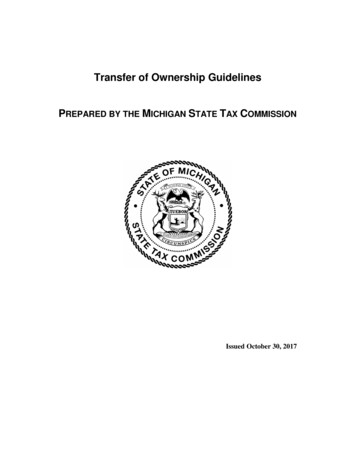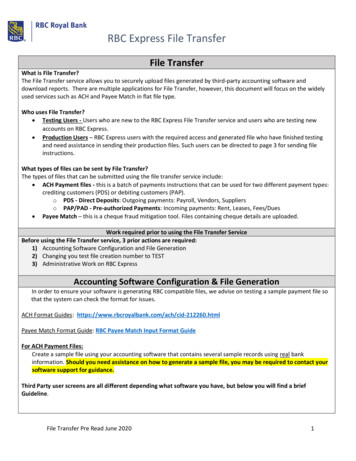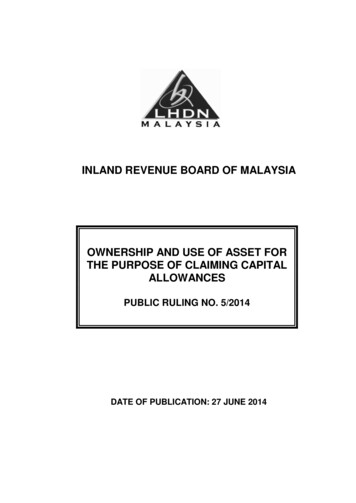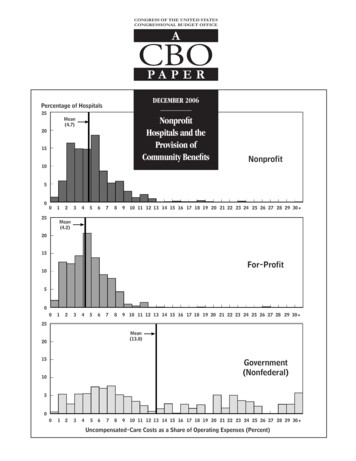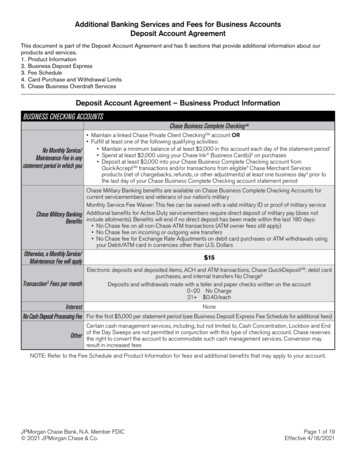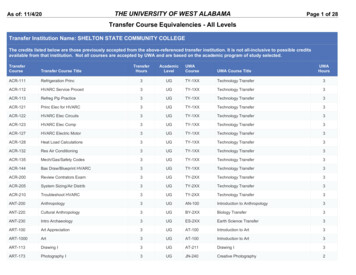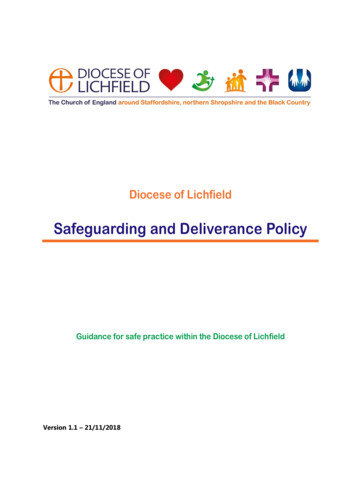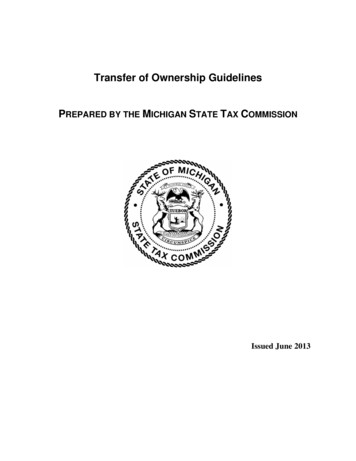
Transcription
Transfer of Ownership GuidelinesPREPARED BY THE MICHIGAN STATE TAX COMMISSIONIssued June 2013
TABLE OF CONTENTSBackground Information1Transfer of Ownership Definitions2Deeds and Land Contracts2Trusts3Distributions Under Wills or By Courts5Leases5Ownership Changes of Legal Entities(Corporations, Partnerships, Limited Liability Companies, etc.)6Tenancies in Common7Cooperative Housing Corporations9Transfer of Ownership Exemptions9Spouses10Children and Other Relatives10Tenancies by the Entireties11Life Leases/Life Estates13Foreclosures and Forfeitures16Redemptions of Tax-Reverted Properties17Trusts18Court Orders18Joint Tenancies18Security Interests24Affiliated Groups25Normal Public Trades26Commonly Controlled Entities27Tax-Free Reorganizations28Qualified Agricultural Properties29Qualified Forest Property32Conservation Easements33Boy Scout, Girl Scout, Camp Fire Girls4-H Clubs or Foundations, YMCA and YWCA33Property Transfer Affidavits34Partial Uncapping Situations36Delayed Uncappings38
Background InformationThe State Tax Commission has issued several Bulletins and memoranda pertaining to transfer ofownership and taxable value uncapping issues:Bulletin No. 16 of 1995 addresses the implementation of the uncapping of an individualproperty's taxable value for a transfer of ownership when the assessor is aware of the transferprior to the adjournment of the March Board of Review.Bulletin No. 8 of 1996 addresses procedures to use when a transfer of ownership is discoveredafter the close of the March Board of Review.A portion of Bulletin No. 3 of 1997 constitutes a supplement to Bulletin No. 16 of 1995.Another portion of Bulletin No. 3 of 1997 covers changes to the prescribed treatment of delayeduncapping situations and constitutes a supplement to Bulletin No. 8 of 1996.Bulletin No. 7 of 2006 addresses the transfer of ownership exemption for qualified agriculturalproperty allowed by Public Act 260 of 2000. Bulletin No. 7 of 2006 constitutes anothersupplement to Bulletin No. 16 of 1995. These Bulletins are available on the State TaxCommission website, www.michigan.gov/statetaxcommission.Bulletin 5 of 2013 addresses P.A. 497 of 2012 regarding transfers to individuals related byaffinity or blood.STC Memorandum issued June 9, 2011 addresses issue related to the Supreme Court decision inthe Klooster Case.Why is a transfer of ownership significant with regard to property taxes?In accordance with the Michigan Constitution as amended by Michigan statutes, a transfer ofownership causes the taxable value of the transferred property to be uncapped in the calendaryear following the year of the transfer of ownership.What is meant by “taxable value”?Taxable value is the value used to calculate the property taxes for a property. In general, thetaxable value multiplied by the appropriate millage rate yields the property taxes for a property.What is meant by “taxable value uncapping”?Except for additions and losses to a property, annual increases in the property’s taxable value arelimited to 1.05 or the inflation rate, whichever is less. In the year following a statutory transferof ownership, that limitation is eliminated and the property’s taxable value is set at 50% of theproperty’s true cash value (i.e., the state equalized value). This is what is meant by “taxablevalue uncapping”. See MCL 211.27a(3).1
Note: A property’s true cash value is usually not the same as its sale price for a variety ofreasons. An assessor must determine the true cash value of a property which has sold in thesame manner that the assessor determines the true cash values of properties which have not sold.Therefore, an assessor may not automatically set an assessed value or a taxable value at halfof a property’s selling price. See State Tax Commission Bulletin No. 19 of 1997 and State TaxCommission Memorandum dated October 25, 2005 that describes the illegal andunconstitutional practice of “following sales.”Can an assessor disregard a statutory transfer of ownership (i.e., can an assessor decide notto uncap a property’s taxable value in the year following a transfer of ownership)?No. By statute an assessor must uncap a property’s taxable value in the year following thetransfer of ownership of that property. The assessor shall set the property’s taxable value for thecalendar year following the year of the transfer of ownership as the property’s state equalizedvaluation for the calendar year following the transfer. See MCL 211.27a(3).Transfer of Ownership DefinitionsWhat is a transfer of ownership?Central to the concept of transfer of ownership is a change in the beneficial use of the property.Michigan statute defines “transfer of ownership” generally as the conveyance of title to or apresent interest in property, including the beneficial use of the property, the value of which issubstantially equal to the value of the fee interest. Michigan Complied Laws (MCL) 211.27a(6)(a-j) provides a variety of examples of what constitutes a transfer of ownership for taxable valueuncapping purposes. If a transfer of property (or ownership interest) meets one of thesedefinitions and does not fall under one of the exceptions or exemptions noted in the law, thattransfer is a transfer of ownership. Transfer of ownership definitions and transfer of ownershipexceptions are contained in MCL 211.27a.(6)(a)-(j) (See appendix). Transfer of ownershipexemptions are contained in MCL 211.27a(7)(a)-(s). (See appendix)Deeds and Land ContractsIs a conveyance of a property by deed a transfer of ownership?A transfer of property by deed is a transfer of ownership. See MCL 211.27a(6)(a).Is a sale by land contract a transfer of ownership?A transfer of property by land contract is a transfer of ownership. See MCL 211.27a(6)(b).If a property is sold by land contract, when does the transfer of ownership occur?The transfer of ownership occurs on the date the land contract is entered into—not the date theland contract is recorded, nor the date the land contract is completed (paid in full) and not the2
date a deed conveying title to the property is recorded in the office of the register of deeds in thecounty in which the property is located.Does a second transfer of ownership occur when a land contract is paid in full and a deedin fulfillment of the land contract is given?No. The law specifically states that a property’s taxable value is not to be uncapped when a deedconveying title to the property is subsequently recorded with the register of deeds.Is the assignment of a seller’s interest in a land contract a transfer of ownership?No, this is considered a transfer of a security interest and is exempt by law from being a transferof ownership.Is the assignment of a buyer’s interest in a land contract a transfer of ownership?Yes, the assignment of a land contract buyer’s interest in a property conveys equitable title to theproperty and a change in the beneficial use of the property occurs resulting in a transfer ofownership.TrustsIs a conveyance of property to a trust a transfer of ownership?Yes. However, if the grantor stated on the deed is the settlor (creator) of the trust or the settlor’sspouse or both and the sole present beneficiary of the trust is the settlor of the trust or thesettlor’s spouse or both, the conveyance is not a transfer of ownership. See MCL 211.27a(6)(c).What or who is a present beneficiary of a trust?A present beneficiary of a trust is the person who has the enjoyment and beneficial use of theproperty during the life of the trust.What or who is a trustee of a trust?A trustee of a trust is the person or agent who is appointed to administer the trust. Note thatbanks are often trustees.Is the trustee (or successor trustee) of a trust the same as the beneficiary of that trust?Not necessarily. The trustee (or successor trustee) of a trust can be, and often is, a completelydifferent individual than the trust’s beneficiary. The beneficiary of a trust is best determinedfrom an examination of the trust instrument.3
Is a transfer of property by a husband and wife to a trust with the husband and wife andtheir child as present beneficiaries a transfer of ownership?Yes. The child is a present beneficiary and is not the settlor of the trust or the settlor’s spouse.Is a transfer of property by a husband and wife to a trust with the husband and wife aspresent beneficiaries and their child as a contingent beneficiary a transfer of ownership?No. The child is not a present beneficiary. The only present beneficiaries are the settlor of thetrust and the settlor’s spouse. The husband and wife are the sole present beneficiaries and fallwithin the exception outlined at MCL 211.27a(6)(c).What or who is a contingent beneficiary of a trust?A contingent beneficiary of a trust is a person who does not currently have the enjoyment andbeneficial use of the property held in trust. The trust document names the contingent event, suchas, the beneficiary’s attaining a certain age, or death of the settlor. If and when the contingentevent occurs, the contingent beneficiary changes status to present beneficiary, and gainsbeneficial use of the property held in trust.Is a conveyance of property which constitutes a distribution from a trust a transfer ofownership?Yes. However, a conveyance of property which is a distribution from a trust is not a transfer ofownership if the distributee is also the sole present beneficiary of the trust or the spouse of thesole present beneficiary or both. See MCL 211.27a(6)(d).Note: Not all transfers of property from trusts are distributions from the trusts. A transfer ofproperty from a trust to someone other than a beneficiary (or contingent beneficiary) of thattrust is not a distribution from that trust. It is simply a transfer of property from a legal entity(the trust) to a person and the transfer should be considered in that context.What happens if the sole present beneficiary of a trust changes?A change in the sole present beneficiary of a trust is a transfer of ownership, unless the changemerely adds or substitutes the spouse of the sole present beneficiary (and provided that nostatutory exception or exemption applies). See MCL 211.27a(6)(e).Is a conveyance of property to a trust a transfer of ownership if: The grantor is the settlor(creator) of the trust or the settlor’s spouse or both. The sole present beneficiary of thetrust is the settlor of the trust or the settlor’s spouse or both.No. If the grantor stated on the deed is the settlor (creator) of the trust or the settlor’s spouse orboth and the sole present beneficiary of the trust is the settlor of the trust or the settlor’s spouseor both, the conveyance is not a transfer of ownership. See MCL 211.27a(7)(f).4
Distributions Under Wills or By CourtsIs a conveyance of a deceased person’s property as directed by a will or as directed by acourt (when there is no will) a transfer of ownership?Yes. Subject to any probate administration that may occur if real property assets are needed tosatisfy debts of the decedent’s estate, title to a decedent’s real property generally passes at thetime of his or her death to any devisees or heirs. However, if the person receiving the property isthe deceased person’s spouse, the conveyance is not a transfer of ownership. See MCL211.27a(6)(f).Note: An exemption from an uncapping exists for judgments or orders of a court of record(without specific monetary consideration for the transfer) are not a transfer of ownership.However, the transfer of ownership definition regarding distributions under a will or by intestatesuccession is considered more specific than—and therefore overrides—this transfer ofownership exemption (even though both statutory provisions may apply).In the case of a distribution of a property under a will or by a court, when does the transferof ownership (if any) occur? (Does the transfer of ownership occur upon the death of theindividual involved, upon the distribution of the property, or at some other time?)The transfer of ownership, if any, typically occurs when the property is probated and conveys thedecedent’s title to real property as of the time of death, whether by will or by intestatesuccession. However, it is possible for a significant amount of time to pass between anindividual’s death and the distribution of that person’s property under a will or by a probatecourt. If the distribution process has not proceeded in a typically timely manner and after aperson’s death but before the distribution of that person’s property, the person’s heir exercisesdominion over the property, a transfer of ownership to the heir is considered to have occurredwhen dominion was first exercised by the heir.Dominion in this context means control or beneficial use of a property, including occupancy,receipt of rents, etc. The relevant considerations when there is a delay in distribution of thedecedent’s estate are whether the distribution process has advanced in a typically timely mannerand whether/when the heir had dominion over the property. Additional information regardingthe progression of the probate estate may best be obtained by reviewing the probate court files.LeasesCan the execution of a lease be a transfer of ownership?Yes. A lease of real property, entered into after December 31, 1994, is a transfer of ownership ifone or both of the following conditions exists:1. The lease term exceeds 35 years, including all options to renew the lease. OR5
2. The lessee has a bargain purchase option. A bargain purchase option is defined by law as theright to purchase the leased property at the end of the lease for 80 percent or less of what theproperty’s projected true cash value at the end of the lease. Even if the lease agreement qualifiesas a “transfer of ownership” under MCL 211.27a(6)(g), the lessee is still required to follow thenotification requirements under 211.27a(10), which states the transferee must notify theassessing officer on the proscribed form within 45 days of the transfer of ownership, to qualify asa transfer of ownership by the taxing unit. (Walgreen’s Co. v. Macomb Twp. (2008) 760 N.W.2d 594, 280 Mich. App. 58).Can the leasing of personal property be considered a transfer of ownership?Generally, no. However, the leasing of personal property that a leasehold improvement, or aleasehold estate can be a transfer of ownership.When a lease is initiated covering only a portion of a real property parcel, and the lease isfor more than 35 years (or contains a bargain purchase option), does a transfer ofownership occur?Yes. However, only the taxable value for that part of the property subject to the lease isuncapped in the year following the transfer of ownership. In other words, a partial uncapping ofthe parcel’s taxable value occurs.If a lessee assigns the lessee’s interest in a lease which had an original term of more than 35years and which has a remaining term of more than 35 years at the time of the leaseassignment, does a transfer of ownership occur?Yes, this is a conveyance by lease of a property with a lease term of more than 35 years and is atransfer of ownership.If a lessee assigns the lessee’s interest in a lease which had an original term of more than 35years and which has a remaining term of 35 years or less at the time of the leaseassignment, does a transfer of ownership occur?No, since the remaining term of the lease is not more than 35 years.Ownership Changes of Legal Entities (Corporations, Partnerships, Limited LiabilityCompanies, etc.)Can the conveyance of an ownership interest of a legal entity (such as a corporation, apartnership, etc.) which owns property be a transfer of ownership—even though title to theproperty remains unchanged?Yes, a conveyance of an ownership interest in a legal entity (such as a corporation, a partnership,etc.) which owns property is a transfer of ownership of that property provided that the ownershipinterest conveyed is more than 50 percent of the total ownership interest. See MCL6
211.27a(6)(h). However, this is not applicable to cooperative housing corporations (discussedseparately).A limited liability company owns real property and conveys of 25.0 percent of theownership interest in 2011. In January of 2012, a conveyance of 25.1 percent of theownership interest of the limited liability company occurred. Did a transfer of ownershipof the real property occur? If so, when?A transfer of ownership of the property owned by the limited liability company occurred inJanuary of 2012 since at that point; more than 50.0 percent of the ownership interest in thelimited liability company had been conveyed. The property’s taxable value is to be 100%uncapped for 2013.As of January of 2011, 50.1 percent of the ownership interest of a limited liability companywas been conveyed and the taxable value of the property was uncapped for 2012. If, inMarch of 2013, 50.0 percent of the ownership interest in the limited liability company isconveyed, does another transfer of ownership occur?No. The percentage of ownership interest conveyed is cumulative from the date of the lasttransfer of ownership. Between January of 2011 and March of 2013, not more than 50.0 percentof the ownership interest is conveyed. Therefore, no transfer of ownership occurs as of March of2013.Company A owns all the membership interest in a limited liability company. The limitedliability company owns a piece of real property. In 2011, Company A sells and conveys itsownership interest in the limited liability company to Company B. Did a transfer ofownership of the property occur?A transfer occurred when Company A sold and transferred its membership interest in the limitedliability company to Company B. Therefore, the property’s taxable value shall be uncapped for2012. See Signature Villas, L.L.C. v. City of Ann Arbor, 269 Mich. App 694, 714 NW2d 392(2006).Tenancies in CommonWhat is a tenancy in common?A tenancy in common is a form of property co-ownership in which two or more persons own theproperty with no right of survivorship between them. When one tenant in common dies, herinterest passes to her heirs or devisees. In this type of shared ownership arrangement title doesnot automatically to the surviving tenant(s) in common.7
Does a tenancy in common require that the tenants in common have equal ownershipshares of the property involved?No. A tenancy in common does not require equal shares. A different, unequal percentage ofownership interest may be established for each tenant in common under a tenancy in common.Is a conveyance of an ownership interest of property held as a tenancy in common atransfer of ownership?Yes. However, the transfer of ownership is only for that portion of the property ownershipwhich is conveyed; meaning a partial uncapping of the property’s taxable value in the yearfollowing the transfer of ownership is possible with tenancies in common. See MCL211.27a(6)(i).Example: Individuals A, B, and C owned a property as tenants in common. Individual A had a50 percent undivided interest in the property and individuals B and C each had a 25 percentundivided interest. In 2012, individual A conveyed his/her interest to individual B (and thisconveyance was a transfer of ownership). Under these circumstances, a partial, 50% uncappingof the property’s taxable value occurs for 2013.How is a tenancy in common established?A tenancy in common is generally established by means of a deed or land contract conveyance.The language relating to the grantees of the deed or land contract establishes the tenancy incommon.Examples: If John Doe conveys property to John Doe and Jim Smith “as tenants in common” atenancy in common is created and Mr. Doe and Mr. Smith are the tenants in common. Likewise,if John Doe conveys property to John Doe and Jim Smith and no language is provided regardingthe nature of their ownership, a tenancy in common is created between Mr. Doe and Mr. Smith.If a property is conveyed to a man and a woman and no information is provided regarding thenature of their ownership, a tenancy in common is formed, unless the man and the woman aremarried at that time, in which case a tenancy by the entireties is created.How can the percentages of undivided ownership interest of the tenants in common bedetermined?Often the deed or land contract establishing the tenancy in common will specify the percentagesof undivided ownership interest of the tenants in common. In the absence of language on thedeed or land contract specifying the percentages of ownership interest of the tenants in common,assessors are advised that it is presumed to be divided equally between the owners unlessevidence to the contrary is presented by the grantor.8
Cooperative Housing CorporationsWhat is a cooperative housing corporation?A cooperative housing corporation is a type of property ownership in which the corporationholds title to a housing complex and individual stock holders in the corporation have the right tooccupy an individual dwelling in that housing complex.Is a conveyance of an ownership interest in a cooperative housing corporation a transfer ofownership?Yes. However, the taxable value of that portion of the property not subject to the ownershipinterest conveyed is not uncapped in the year following the conveyance. In other words, a partialtaxable value uncapping can occur for a cooperative housing corporation. See MCL211.27a(6)(j).Note: The law states that a transfer of ownership occurs when more than 50 percent of theownership interest of a corporation changes. Beginning in 1997, this law was no longerapplicable to cooperative housing corporations.What happens if a cooperative housing corporation, during 2012, conveys 15 out of 100shares of stock?A transfer of ownership occurs. Since 15 of 100 shares transferred in 2012, 15 percent of thetaxable value of the cooperative housing corporation is to be uncapped for 2013.Transfer of Ownership ExemptionsWhat is a transfer of ownership exemption?Michigan law specifies that certain transfers of property and ownership interests are not transfersof ownership for taxable value uncapping purposes. These types of transfers are known asexempt transfers and the statutes that provide for these exempt transfers are known as transfer ofownership exemptions. Transfer of ownership exemptions are contained in MCL 211.27a.(7)(a)(s).It is a solidly established principal that property tax “exemption statutes are to be strictlyconstrued in favor of the taxing unit and against the exemption claimant.” Association of LittleFriends, Inc. v City of Escanaba, 138 Mich. App 302; 362 NW2d 602 (1984); Town & CountryDodge Inc. v Department of Treasury, 420 Mich. 226; 362 NW2d 618 (1984); Inter Co-opCouncil v Tax Tribunal Dept. of Treasury, 257 Mich. App 219; 668 NW2d 181 (2003).It is also well established that a person or entity seeking a property tax exemption mustdemonstrate entitlement to the exemption by a preponderance of the evidence and that a propertytax exemption cannot be inferred or implied. Holland Home v City of Grand Rapids, 219 Mich.9
App 384, 394; 557 NW2d 118 (1996); Michigan United Conservation Clubs v LansingTownship, 129 Mich. App 1, 11 (1983).Since a transfer of ownership exemption is simply a form of property tax exemption, it is theopinion of the State Tax Commission that the principals which apply to general property taxexemptions also apply to transfer of ownership exemptions. Therefore, transfer of ownershipexemption statutes must be strictly interpreted against the person or entity claiming theexemption and in favor of the local taxing unit. Assessors must not infer a transfer of ownershipexemption or grant a transfer of ownership exemption based on implication.SpousesIs a transfer of property from one spouse to the other spouse a transfer of ownership?No, generally a transfer of property from one spouse to another spouse is not a transfer ofownership. See MCL 211.27a(7)(a) and MCL 211.27a(7)(s).Is a transfer of property from a deceased spouse to a surviving spouse a transfer ofownership? See MCL 211.27a(7)(a).As a general rule, a transfer of property from a deceased spouse to a surviving spouse is not atransfer of ownership.Is a transfer of property between former (divorced) spouses a transfer of ownership?Yes. No transfer of ownership exemption exists for property transfers between divorcedspouses. However, oftentimes recently divorced spouses must convey property to one another aspart of the divorce proceedings and these transfers of property may be exempt transfers if theconveyances are solely to terminate a tenancy by the entireties (covered later in this publication).Is a transfer of property from one spouse to a limited liability company with the otherspouse as the only member of the limited liability company a transfer of ownership?Yes. Even though the second spouse completely controls the limited liability company, thelimited liability company is not the second spouse. A limited liability company is a separate anddistinct legal entity, different from a person. Therefore, such a situation is not a transfer betweenspouses and is a transfer of ownership applies.Children and Other RelativesIs a transfer of property from a parent to a child a transfer of ownership?Beginning with transfers occurring on and after December 31, 2013 only, no but only forproperty classified residential real and if the use of the real property does not change followingthe transfer of ownership.10
Does this include adopted children?Yes, P.A. 497 of 2012 indicated that beginning December 31, 2013, a transfer of residentialreal property is not a transfer of ownership if the transferee is related to the transferor byblood or affinity to the first degree and the use of the property does not change following thetransfer of ownership. See MCL 211.27a(7)(s).Does this include relatives other than those related by blood?Affinity to the first degree includes the following relationships: spouse, father or mother, fatheror mother of the spouse, son or daughter, including adopted children and son or daughter of thespouse.When does this provision go into effect?P.A. 497 of 2012 indicates that this provision is effective beginning December 31, 2013.Therefore, it is in effect only for transfers that occur on December 31, 2013 and after.John and Jane Doe transfer their residential real property to their daughter Judy onDecember 1, 2013. Is this a transfer of ownership?Yes, as long as no other exemption provisions apply.John and Jane Doe transfer their residential real property to their daughter Judy onJanuary 15, 2014. Is this a transfer of ownership?No, as long as Judy maintains the same use of the property. MCL 211.7a(7)(s).John and Jane Doe transfer their residential real property to their son Jack on March 1,2014. Jack decides he wants to turn the house into a vacation rental home. Is this atransfer of ownership?Yes, as long as no other exemption provisions apply because Jack has not maintained the use ofthe property.Tenancies by the EntiretiesWhat is a tenancy by the entireties and how are they established?A tenancy by the entireties is a form of concurrent ownership that can be created only between ahusband and wife, holding as one person. When the husband or wife dies, the surviving spouseautomatically becomes the sole owner of the property. In a tenancy by the entireties, neither thehusband nor the wife may sell the property unless the other consents to the sale. Tenancies byentireties enjoy the same rights of survivorship as joint tenancy.11
A tenancy by the entireties is established by means of a deed or land contract conveyance. Thelanguage relating to the grantees on the deed or land contract establishes the tenancy by theentireties.Example: If John Doe conveys property to John Doe and Jane Doe “his wife”, a tenancy by theentireties is created. Likewise, if Jane Doe conveys property to John Doe and Jane Doe“husband and wife” or “as tenants by the entireties”, a tenancy by the entireties is created.Similarly, if John Doe conveys property to John Doe and Jane Doe and no language is providedregarding the nature of their ownership, a tenancy by the entireties is formed—provided thatJohn Doe and Jane Doe are, in fact, husband and wife.Is a property conveyance completed solely to create or end a tenancy by the entireties atransfer of ownership?No. A transfer from a husband, a wife, or both whose sole purpose is to create or disjoin(terminate) a tenancy by the entireties is not a transfer of ownership. See MCL 211.27a(7)(b).John Doe and Jane Doe are married. They acquire property from a third party, creating atenancy by the entireties. Is this acquisition of property a transfer of ownership?Yes. Although a tenancy by the entireties is created by the Does when they acquire the property,the creation of the tenancy by the entireties is not the sole purpose of the transaction (the mainpurpose of the transaction is for the Does to acquire the property) and a transfer of ownershipoccurs.John Doe and Jane Doe were married and owned property as husband and wife. Theydivorce and (directly associated with the divorce) they deed the property from themselvesas husband and wife to Jane Doe, a single woman. Is this conveyance a transfer ofownership?No, since its purpose was solely to terminate the tenancy by the entireties.John Doe owns a parcel and then marries Jane Smith who decides to take the surname“Doe”. John Doe then conveys the parcel to John Doe and Jane Doe, as husband and wife.Is this conveyance a transfer of ownership?No, since its purpose is solely to create a tenancy by the entireties in the Does.John Doe and Jane Doe are married and own a property as husband and wife. They sell theproperty to a third party. Is this sale a transfer of ownership?Yes, the purpose of the conveyance is to sell the property and not solely to end the tenancy bythe entireties.12
If a divorce occurs in a tenancy by the entireties situation, does the form of owners
See MCL 211.27a(6)(a). Is a sale by land contract a transfer of ownership? A transfer of property by land contract is a transfer of ownership. See MCL 211.27a(6)(b). If a property is sold by land contract, when does the transfer of ownership occur? The transfer of ownership occurs on the date the land contract is entered into—not the date the
